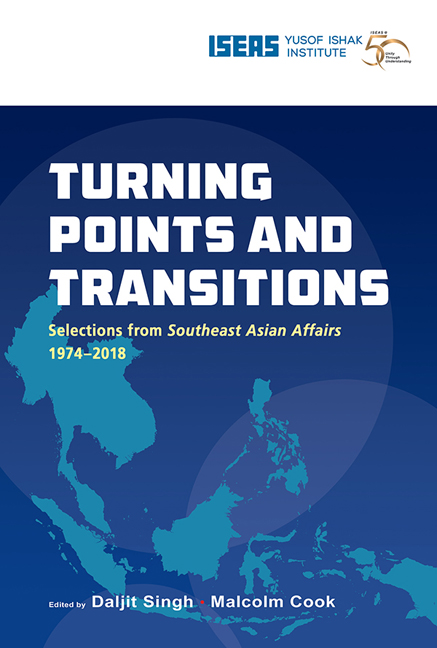Book contents
- Frontmatter
- Contents
- Message from the Director
- Foreword
- Foreword
- Introduction
- THE REGION
- The Diplomatic Emergence of China and Its Implications for Southeast Asia (1975*)
- Stability and Security in the Region after ANZUK (1975)
- The Question of the “Overseas Chinese” (1976)
- Southeast Asia 1976: The Handling of Contradictions (1977)
- The “Fukuda Doctrine” and Its Implications for Southeast Asia (1978)
- Expanding Horizons in Southeast Asia? (1994)
- AFTA in the Light of New Economic Developments (1995)
- The ASEAN Economic Miracle Unravels (1999)
- Southeast Asia in 1999: A False Dawn? (2000)
- East Timor's Future: Southeast Asian or South Pacific? (2001)
- Southeast Asia in 2002: From Bali to Iraq — Co-operating for Security (2003)
- The Year in ASEAN: The Charter, Trade Agreements, and the Global Economic Crisis (2010)
- Seeking Stability in Turbulent Times: Southeast Asia's New Normal? (2015)
- China's Two Silk Roads Initiative: What It Means for Southeast Asia (2015)
- China's International Strategy and Its Implications for Southeast Asia (2016)
- BRUNEI
- CAMBODIA
- INDONESIA
- LAOS
- MALAYSIA
- MYANMAR
- THE PHILIPPINES
- SINGAPORE
- THAILAND
- VIETNAM
Southeast Asia 1976: The Handling of Contradictions (1977)
from THE REGION
Published online by Cambridge University Press: 29 May 2019
- Frontmatter
- Contents
- Message from the Director
- Foreword
- Foreword
- Introduction
- THE REGION
- The Diplomatic Emergence of China and Its Implications for Southeast Asia (1975*)
- Stability and Security in the Region after ANZUK (1975)
- The Question of the “Overseas Chinese” (1976)
- Southeast Asia 1976: The Handling of Contradictions (1977)
- The “Fukuda Doctrine” and Its Implications for Southeast Asia (1978)
- Expanding Horizons in Southeast Asia? (1994)
- AFTA in the Light of New Economic Developments (1995)
- The ASEAN Economic Miracle Unravels (1999)
- Southeast Asia in 1999: A False Dawn? (2000)
- East Timor's Future: Southeast Asian or South Pacific? (2001)
- Southeast Asia in 2002: From Bali to Iraq — Co-operating for Security (2003)
- The Year in ASEAN: The Charter, Trade Agreements, and the Global Economic Crisis (2010)
- Seeking Stability in Turbulent Times: Southeast Asia's New Normal? (2015)
- China's Two Silk Roads Initiative: What It Means for Southeast Asia (2015)
- China's International Strategy and Its Implications for Southeast Asia (2016)
- BRUNEI
- CAMBODIA
- INDONESIA
- LAOS
- MALAYSIA
- MYANMAR
- THE PHILIPPINES
- SINGAPORE
- THAILAND
- VIETNAM
Summary
The main variable of Southeast Asian politics in 1976 was the emergence and institutionalization of the communist governments in Indochina. International politics in the region was primarily responses arising from this fact, involving mutual assessment, diplomatic fencing and a series of attempts by the various governments adhering to basically two ideologically contradictory political systems to formulate a working relationship. For the noncommunist governments of Indonesia, Malaysia, the Philippines, Singapore and Thailand, even the anticipation of an eventual communist takeover in South Vietnam did not prepare them for the swiftness and the completeness of the communist victories throughout 1975. The Cambodian proclamation of a revolutionary government on 17 April was followed by the entry of North Vietnamese troops into Saigon on 30 April and, only a few months later, a bloodless transition of power took place within the coalition government in Laos, leaving the Pathet Lao in total control of the country by the end of November. Domestic politics in the noncommunist states was not solely a function of the external threat of communism, but political issues were recognizably forced or attenuated by the considerations of internal subversion, the weakening of the political will of leaderships and the need to build up national resilience, particularly in states which are the nearest neighbours of Indochina. In the new communist states the concern, domestically, was to create an administrative infrastructure to facilitate economic development and reconstruction and the protection of their territorial borders and newly gained sovereignty.
For the student of politics interested in unravelling the meaning behind the packed events and developments in the area a year after the establishment of the three communist regimes in Southeast Asia, it may be efficient to utilize the theme of the confrontation of contradictions, for without any question the noncommunist governments in the region have to deal with the presence of a fundamentally different, if not opposed, political force — communist governments which have emerged as a regional power very suddenly. This article will explore the handling of this contradiction from the stand point of the noncommunist states of ASEAN and that of communist Vietnam, Laos and Cambodia. It proposes to examine first, the perceptions of the ASEAN states of the political situation and their policies; secondly, the perceptions, priorities and policies of the communist states; and thirdly, the dialogue and interaction between the ASEAN and the lndochinese states.
- Type
- Chapter
- Information
- Turning Points and TransitionsSelections from Southeast Asian Affairs 1974-2018, pp. 32 - 53Publisher: ISEAS–Yusof Ishak InstitutePrint publication year: 2018

